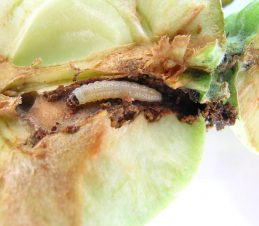What is a codling moth?

BC Ministry of Agriculture
A codling moth is a small, grayish moth whose larva feeds on apples and related fruit.
The codling moth has been a principal pest of apple and pear in North America for more than 200 years. The fruit is commonly described as being “wormy” when you have a codling moth infestation. This is because the larvae feed on the fruit by boring deep into the core and spoiling it. The adult moths are small and usually gray or brown in colour. If uncontrolled, codling moth can damage most of the fruit crop on a tree. The codling moth can produce from 1 to 3 generations per year in the Okanagan.
Where do they live?

Codling Moths Prefer Apple Trees
Codling moths are found almost worldwide.
They are the major fruit-feeding pest in fruit growing regions of western North America.
Codling moths prefer apple trees but also attack pear, crabapple, quince, walnut and Oriental pear trees in the Okanagan, Similkameen, and Shuswap Valleys.
Pears are resistant to attack when small because of their hardness but can become heavily infested in late summer as they mature. Infestations in stone fruits such as apricot and cherry are extremely rare and usually occur only where heavy infestations of apple or pear are nearby.
When do they appear?
The codling moth, like all insects, is cold blooded. Meaning, the temperature around it determines how fast it grows and how active it is as an adult moth. We can take advantage of this fact to predict what life stage the majority of the codling moths in population are in. Scientists have developed a model that uses degree-days to predict codling moth development. These predictions are summarized in this table.
| Degree day total (± 3-5 DD) |
Codling moth stage of development |
| 100 | Emergence of 1st brood moths from overwintering larvae |
| 150 | Beginning of 1st brood egg laying |
| 220 | Start of 1st egg hatch (first brood larvae) |
| 500 | End of emergence of 1st brood moths |
| 575 | Start of emergence of 2nd brood moths |
| 650 | End of 1st brood egg hatch |
| 700 | Start of 2nd brood egg hatch (2nd brood larvae) |
| 1140 | End of 2nd brood moth emergence |
| 1160 | Start of 3rd brood moth emergence |
| 1275 | End of 2nd brood egg hatch |
| 1300 | Start of 3rd brood egg hatch |
